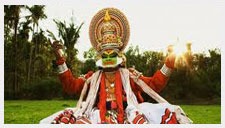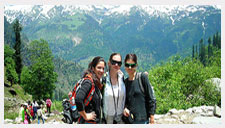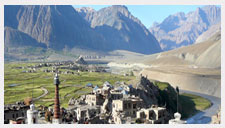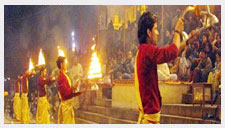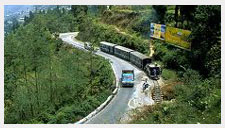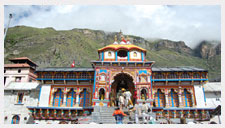About chardham
Char Dham. Char Dham (Devanagari: चार धाम) (literally: 'the four abodes/seats') are the names of four piligrimage places in India that are widely revered by most of the "Hindus". They are: Badrinath, Dwarka, Jagannath Puri, and Rameshwaram.[citation needed]. The Char Dham defined by Adi Shankaracharya consists of three Vaishnavite, one Shaivite, and one mixed site. Over the years, the term "Char Dham" has lent itself to the all-denomination Char Dham pilgrimages in the Garhwal Himalayas, where Adi Shankaracharya attained freedom from embodiment. Earlier known as Chota Char Dham or 'Little' Char Dham to differentiate them from the bigger circuit of Char Dham sites, after the mid-20th century they themselves started being called the Char Dham[1] Today, the term "Char Dham" usually refers to the all-denomination Himalayan Char Dham. The Char Dham are often considered the most revered sites for Hindus that have to be visited in one's lifetime.
History
The four temples comprise of Badrinath, Rameswaram, Puri and Dwarka.[2] Though the origins are not clearly known, the Advaita school of Hinduism established by Sankaracharya, who created Hindu monastic institutions across India, attributes the origin of Char Dham to the seer.[citation needed] The four monasteries lie across the four corners of India and their attendant temples are Badrinath Temple at Badrinath in the North, Jagannath Temple at Puri in the East, Dwarakadheesh Temple at Dwarka in the West and Ramanathaswamy Temple at Rameswaram in the South. Though ideologically the temples are divided between the sects of Hinduism, namely Saivism and Vaishnavism, the Char Dham pilgrimage is an all Hindu affair.[3] There are four abodes in Himalayas called Chota Char Dham (Chota meaning small): Badrinath, Kedarnath, Gangotri and Yamunotri - all of these lie at the foot hills of Himalayas.[citation needed] The name Chota was added during the mid of 20th century to differentiate the original Char Dhams.[citation needed] The journey across the four cardinal points in India is considered sacred by Hindus who aspire to visit these temples once in their lifetime.[4] Traditionally the trip starts are the eastern end from Puri, proceeding in clockwise direction in a manner typically followed for circuambulation in Hindu temples.[4] Geographically speaking the char dham make a perfect square with Badrinath and Rameswaram falling on the same longitude and Dwarka (old) and Puri on the same latitude, representing the farthest north, east, west, and south points of India (at that time, before coastlines changed)
Pilgrimage Centers
Badrinath Temple, Badrinath
Badrinath is located in the North Indian state of Uttarakhand. It is in the Garhwal hills, on the banks of the Alaknanda River. The town lies between the Nar and Narayana mountain ranges and in the shadow of Nilkantha peak (6,560m).
Badri refers to a berry that was said to grow abundantly in the area, and nath means Lord. The legend goes that Shankara discovered a black stone image of Lord Badrinarayan made of Saligram stone in the Alaknanda river. He originally enshrined it in a cave near the Tapt Kund hot springs. In the sixteenth century, the King of Garhwal moved the murti to the present temple.
Dwarka located in the West is in the state of Gujarat, India. The city derives its name from word dvar meaning door or gate in the Sanskrit language. It is located close to where the Gomti River merges into the Gulf of Kutch. The city lies in the westernmost part of India. The legendary city of Dwaraka was the dwelling place of Lord Krishna. It is believed that due to damage and destruction by the sea, Dvaraka has submerged six times and modern day Dwarka is the 7th such city to be built in the area.
Jagannath Temple, Puri
Puri located in the East is located in the state of Orissa, India. Puri is one of the oldest cities in the eastern part of the country. It is situated on the coast of the Bay of Bengal.
The main deity is Shri Krishna, celebrated as Lord Jagannatha. It is the only shrine in India, where goddess, Subhadra, sister of Lord Krishna is worshipped along with her brothers, Lord Jagannatha and Lord Balabhadra. The main temple here is about 1000 years old and constructed by Raja ChodaGanga Deva and Raja Tritiya Ananga Bhima Deva. Puri is the site of the Govardhana Matha, one of the four cardinal institutions or Mathas established by Adi Shankaracharya.
Brahma, Vishnu & Maheswara three are together in alltime every place. In Kali yuga Sreemandir as jagannath temple in Puri. Jagannath-Vishnu, Balabhadra-Maheswara & Subhadra-Brahma. This is the plume for Oriya people to celebrate a special day in this Dham which is also known as "Chariot Festival".
Ramanathaswamy Temple, Rameswaram
Rameswaram located in the South is in the Indian state of Tamil Nadu. It is situated in the Gulf of Mannar at the very tip of the Indian peninsula. According to legends, this is the place from where Lord Rama, built a bridge Ram Setu to Lanka. The Ramanatha Swamy Temple dedicated to Lord Shiva occupies a major area of Rameshwaram. The temple is believed to have been consecrated by Shri Rama.
Rameshwaram is significant for the Hindus as a pilgrimage to Benaras is incomplete without a pilgrimage to Rameswaram. The presiding deity here is in the form of a Linga with the name Sri Ramanatha Swamy, it also is one of the twelve Jyotirlingas.
Brahma, Vishnu & Maheswara three are together in alltime every place. Rama-Bishnu, Laxman-Brahma & Hanuman-Maheswara









